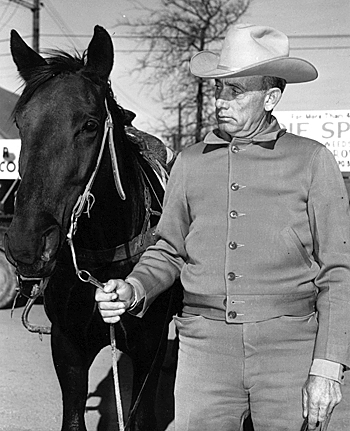
Thanks to George Glascock, Cresson, Texas was dubbed the “cutting capitol of the world,” long before its neighbor Weatherford adopted the title.
Glascock, a founding member of the National Cutting Horse Association, won the first three NCHA world championship titles (1946-1948) and was inducted into the NCHA Hall of Fame in 1977, by former Texas governor John Connally.
Born in 1897, Glascock grew up on a ranch in Stephens County, 60 miles southwest of Fort Worth. As a boy, he hired himself out as a day worker on neighboring ranches, but took a job as an oilfield tool dresser in 1922, when he married Bessie Harrell, a cowboy’s daughter from Eastland County, the center of the 1920’s West Texas oil boom.
In 1935, the Glascocks purchased a ranch in Cresson, and although they moved “to town” in their later years, George was a Cresson resident until his death in 1991, at age 94. By then, he owned ranches in three counties.
In the early years, Glascock employed Bessie’s brothers, Fred and Guy Harrell, to help run the ranch, along with Hughie Long, a Canadian champion bareback bronc and bull rider, who trained horses for Glascock. At the time, Glascock raised Brahman bulls and supplied the Fort Worth Stock Show Rodeo with its bucking stock.
It was at the 1946 Fort Worth Stock Show that Glascock and 12 other ranchers formed the National Cutting Horse Association – the same year that Glascock won the cutting event on Benny Binion’s Gelding to become the first NCHA world champion.
“George Glascock was my idol,” said Brenda Michael, daughter of the late Benny Binion, a famous Las Vegas casino owner, horseman and rancher. “When they retired (Benny Binion’s Gelding) and brought him back to Las Vegas in 1948, I showed him some as a child and rode him through my early teen years.”
Binion, a Texas native, owned a ranch near Cresson, as well as a much larger spread in Montana where he kept 800 horses of all descriptions. It was in Montana that his soon to be famous gelding was foaled in 1939, out of a “Spanish” mare of unknown parentage and sired by a fashionable Thoroughbred named Band Time.
“My father had everything, even draft horses and mules,” said Michael. “In the old days, they didn’t raise horses for cutting. They’d take a horse that showed a lot of cow and go on with it.
“In 1960, I made the finals of the Fort Worth Stock Show Rodeo on Silverlight, who had been fourth in the World standings. He was a stud and my father bought him to cross on some Galiceno pony mares because he was small.”
Glascock noticed Benny Binion’s Gelding in a lot of horses that two cowboys were breaking on Binion’s ranch near Cresson. With Binion’s blessing, Glascock took the horse home with him and used him to sort and cut 800 head of cattle bound for market. Soon, Glascock was showing the horse in cutting competitions.
Retired, after a final win with Glascock in the 1949 Houston Livestock Rodeo, the gelding lived out his years on Binion’s ranch in Montana, where he died in 1964, at the age of 25.
Glascock’s influence on cutting lasted well beyond his world championship days. In the late 1940s and 1950s, he held cutting events at his ranch that drew as many as 300 entries. Later, when the NCHA Futurity was initiated, he began supplying cattle for that event, as well as for the Fort Worth Stock Show and the Dallas State Fair.
